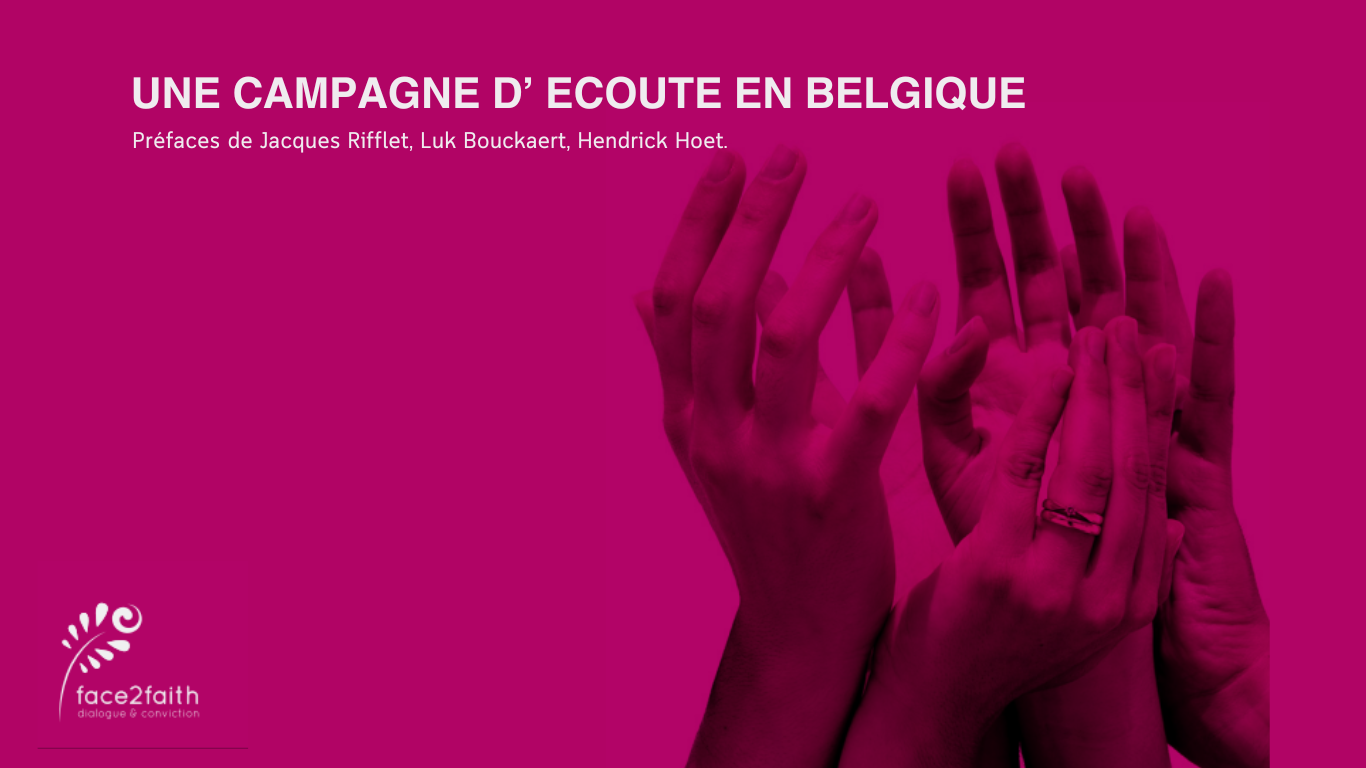
n
In 2012, thanks to the support of numerous donors and of UniOne, a group of people under the chairmanship of Laurent Ledoux started to gather at the Brussels’ UniOne House.
The goal was to launch a listening campaign and to produce a report on the conditions for a fruitful dialogue between people with different beliefs and convictions, ie. not an interreligious or interfaith dialogue but an “interconvictional” dialogue including believers s well as agnostics and atheists of any kind.
The listening campaign, which was called “face2faith, dialogue & conviction” was formulated as follow to nurture a movement for inter-faiths & -convictions dialogues (between people of different faiths or convictions, i.e. including atheists and agnostics) and cooperation, in particular between existing Belgian associations active in this field on the one hand and, on the other, any citizen wishing to get involved in such dialogues.
To give the project a methodologically sound footing, 400 interviews and focus groups we carried out. The results allowed among other things to dissect the ways in which individuals themselves use the terms religion, faith and conviction, to describe the cosmologies in which the respondents evolve, to analyze the lines of tension that run through their words, and to carefully draw conclusions from the results in order to give us something to act upon.
By so doing the report helps to understand the implications of our beliefs and convictions. Far from adopting a soothing approach to inter-faiths & -convictions dialogues, the report attempts on the contrary – going beyond the respondents’ commonplace support for respect for others – to “scrape away the conscious or unconscious varnish that hides the real lines of tension” between them.
The Report’s final recommendations – fully detailed in the Reports below – are:
2.1. Reconcile the religious and the secular: Interreligious dialogue must be extended to an interconvictionnal dialogue between people of different convictions, both religious and non-religious. The Report shows it is possible. Indeed, questions of meaning are neither the prerogative of the religious nor of the secular universe.
2.2. Ask the right questions for a resolutely performative dialogue: The main criticism levelled at the usual dialogues between people of different faiths or convictions is their often-soothing nature: they avoid the fault lines. The Report shows we should not be afraid to deal with issues “that make people angry”. Dialogue should not be only an opportunity for fraternization; it should also be a potential forum for negotiating differences. The treatment of substantive issues should also facilitate the emergence of grassroots initiatives between the participants and thus lend a performative tone to the interconvictionnal dialogue.
2.3. Actively involve young people to refresh the dialogue: Young interviewed people said they were relatively disconcerted by an adult world that did not take them seriously. Involving young people in an interconvictionnal dialogue should therefore give them a responsible experience with a pro-social dimension, breaking down the generation gap and giving them the credibility, they feel they lack.
2.4. Get involved in schools: The question of interfaith relations is increasingly becoming the central issue during philosophy courses in Belgian schools. There is in particular a need to put traditions into perspective and to break down communitarian phenomena. Introducing interconvictionnal dialogues into schools is considered to be the most effective ways of fulfilling the previous recommendation of involving young people in such dialogues.
2.5. Diversify dialogue activities so as not to limit ourselves: As a respondent clearly put it: “Let’s leave the ideas to one side… Let’s eat together instead!” Indeed, a dialogue is first and foremost a plural involvement in an activity of sharing. A simple get-together, a play, a musical event, various forms of artistic expression, the use of humor or even a shared moment of silence can all be ways of engaging in dialogue in the sense of sharing. Opening interconvictionnal dialogues to artistic, culinary or musical expressions, etc., should allow to capitalize on the diversity and skills of each person and thus allow the various facets of the human being to be seen and exchanged.
2.6. Set up networking structures to coordinate interconvictionnal dialogues: Many young and old people involved in the promotion of such dialogues told us about their difficulties, particularly in terms of identifying relevant and diverse stakeholders to support the organization and promotion of such dialogues, to help identify speakers, … There is thus a real need for “relay points” to bring together and manage the network of associations involved in interconvictionnal dialogues in Belgium. These associations typically do not know each other and, consequently, very rarely cooperate, thereby losing the benefits of joint action.
The final reports, which were published in French & Dutch, can be found hereunder. A version in English (translated by Deepl and hence still possibly containing translation errors) can also be found hereunder.
The Listening Campaign & Reporting team included Hicham Abdel Gawad, Christof Grootaers, Miriam Lemmens, Liesbeth Maris, Fien Ingelbrechts, Nicolas Marquis, Giusto Maniscalchi, Marie de Carnière and Mary Wigny.
The Report Advisory Committee included Laurent Ledoux, Frans Goetghebeur, Daniel Schaubacher, Vincent Legrand, Karim Chemlal, Marianne Goffoël, Johan Vrints, Alain Deneef, Pierre Paul Delvaux, Christine Kulakowski, Baudoin de Mérode, and Pierre Gehot.
